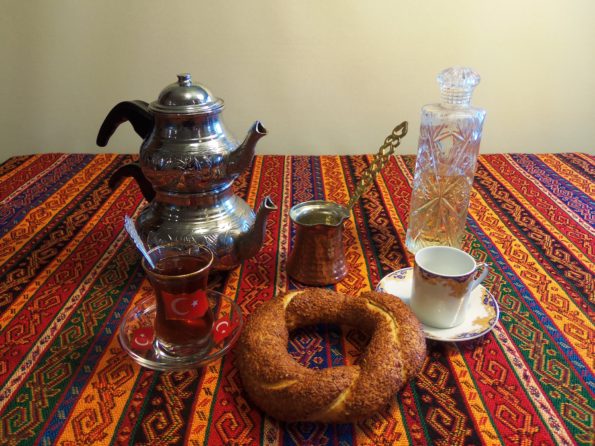Turkish Tea
Black tea is very important in Turkish culture as well as cuisine. When a Westerner hears the word chai they often think of a tea latte with frothed milk and spices. Although the Turkish word, çay, is pronounced exactly the same it simply means tea. Turks like to drink their tea piping hot at all hours of the day. Although çay is served with breakfast it is generally served after other meals, not directly along with the food. Turks drink tea for the taste but it is also a sign of hospitality. Of course if you are a guest in someone’s home you will be served endless cups of tea, but you may also be offered tea as you shop and conduct business. Just last week I went to a tailor’s shop nearby to drop off some mending and when I returned to pick up my clothing he offered a steaming cup of çay, just like the man at the hardware store had done earlier. Often men can be seen carrying shiny trays filled with glasses of tea as he goes from shop to shop delivering çay to those working as well as their patrons.

There is a folk saying which clearly explains the importance of tea in the daily culture here: Çaysız sohbet, aysız gökyüzü gibidir (conversations without tea are like a night sky without the moon). All throughout the country you will find teahouses where men gather late into the night to spend time with friends as they discuss politics and soccer scores while drinking tea. Backgammon and a rummy cube type of game, called Okey, are two traditional games men play while sipping tea with friends and chatting in these teahouses.
Turkey has the highest per capita tea consumption in the world at almost 7 pounds of tea per person per year! The next highest is Ireland at 4.83 pounds and China only consumes about 1.25 pounds of tea per person per year. While studies show that the typical Turk will drink at least 10 cups of çay per day, living here I can attest to the fact that most drink many more than that. It is believed that this great love of tea began during World War I when coffee was incredibly expensive to import. Turkey’s founder and 1st president, Mustafa Kemal Ataturk, encouraged Turks to drink tea since it could be grown locally. Rize, a province in Northeast Turkey along the Black Sea, is credited with growing the best çay. Turkish grocery stores offer a plethora of black tea options. Often Turks will mix something like Bergomat tea in with a plain choice like Rize or Filiz.

Turkish tea is brewed in a very unique way. Because Turks like to drink tea all day long, and because they are an extremely hospitable people and always want to be ready to serve guests, the çaydanlık (teapot) they use is incredibly helpful. It’s design both keeps the tea hot without getting bitter and allows each cup poured to be made especially suited for the drinker. While a Turkish teapot can be metal or porcelain, plain or very decorative, the most distinctive feature is that there are always two stacked kettles/pots. The larger one is on bottom and the smaller one on top, often with a sieve to hold tea leaves. Before placing it on the stove, the bottom pot is filled with water, while loose çay leaves are put in the top part. When the water in the bottom pot begins to boil it is poured in a circular motion over the tea leaves in the top part. Then more water is added to the bottom pot before placing it on the stove again. As the water in the bottom begins to heat, the tea up top will steep into a nice strong brew. (Generally allow about 2 Tablespoons of tea leaves in the top per 1 ½ – 2 cups water. The more you make it you will figure out the exact ratio you enjoy.)
 Turkish tea glasses are also very distinctive as they are small and tulip shaped. This unique shape allows the tea near the top to cool quickly enough for you to begin to drink while the tea in the bottom protion of the glass remains steaming hot. When the tea is sufficiently steeped, your host will often pour some steaming water from the bottom pot into each of the glasses and swish it around before discarding it again. This warms the glass up so it won’t crack, as well as ensuring the guests that they are getting a very clean cup. Your host will pour some strong tea from the top pot into your cup, about 1/3 full. The remaining portion of the glass will be filled with the hot water from the bottom pot. The goal is that the tea in the glass is the color of rabbit’s blood or tavşan kanı. If you prefer weaker tea it is polite to say açık olsun (may it be light). Since the tea will be served to you steaming hot, make sure to hold the rim of the tea glass to avoid burning your fingers as you sip it. In shops you will be served two sugar cubes on your çay saucer while in someone’s home there’s often a bowl of sugar cubes nearby. It’s not uncommon for Turks to drink their tea without any sugar, but some prefer to sweeten it with 1 or 2 sugar cubes. In Eastern Turkey there’s a tradition of kıtlama çayı where you don’t add sugar to your tea but hold the cube behind your teeth or under your tongue. As you drink several glasses of tea it will taste sweet as the cube slowly dissolves.
Turkish tea glasses are also very distinctive as they are small and tulip shaped. This unique shape allows the tea near the top to cool quickly enough for you to begin to drink while the tea in the bottom protion of the glass remains steaming hot. When the tea is sufficiently steeped, your host will often pour some steaming water from the bottom pot into each of the glasses and swish it around before discarding it again. This warms the glass up so it won’t crack, as well as ensuring the guests that they are getting a very clean cup. Your host will pour some strong tea from the top pot into your cup, about 1/3 full. The remaining portion of the glass will be filled with the hot water from the bottom pot. The goal is that the tea in the glass is the color of rabbit’s blood or tavşan kanı. If you prefer weaker tea it is polite to say açık olsun (may it be light). Since the tea will be served to you steaming hot, make sure to hold the rim of the tea glass to avoid burning your fingers as you sip it. In shops you will be served two sugar cubes on your çay saucer while in someone’s home there’s often a bowl of sugar cubes nearby. It’s not uncommon for Turks to drink their tea without any sugar, but some prefer to sweeten it with 1 or 2 sugar cubes. In Eastern Turkey there’s a tradition of kıtlama çayı where you don’t add sugar to your tea but hold the cube behind your teeth or under your tongue. As you drink several glasses of tea it will taste sweet as the cube slowly dissolves.
Çay glasses are refilled many times, especially if you drain everything in the glass. If you wish to politely tell your host you don’t want anymore simply turn your teaspoon upside down over the glass rim like in the picture below so your host knows you are satisfied.



Sylvia Helser
I have enjoyed learning about Turkish tea etiquette. Thank you for the lesson.
This makes me want to be a traveler/guest in Turkey!
I will keep this web site handy, because it is well written and oh, so interesting.
Someday soon, I will make some of the recipes and enjoy sharing the food, too.
With thanks and admiration,
Sylvia Helser from Wheaton, Illinois, USA
Becky Wiebe
I didn’t know about the teaspoon signal. Great tip! We drank a lot of çay everywhere. I wanted one from the man with a tray on the street…but I noticed he’d give one to someone (glass cup) and keep walking. How do they get the cups back? 🤔 Want to learn how to do that for next time.
Jale
Hi Becky, thanks so much for reading and responding! The men on the street with trays who walk around handing out glass cups of çay come back later to collect them. They don’t usually sell to customers, just shop owners and those working who will remain at the same location when they make their next round to collect cups. True to the great Turkish hospitality (and because they want to make a sale) sometimes a shop owner may invite you as a customer to have a cup of tea with them and they will buy for you from the man walking around selling çay. Then after you are finished drinking together just leave your cup in the shop and the owner will return it when the man comes around next. Hope this helps.